| |
| ... |
|
|
|
|
|
| |
| December 9, 2007 |
|
Weekend 11 - The curtain drops
Pat Young reports: Unseasonably warm weather (65-70 deg.), sunny skies and a slight breeze were enjoyed by this weekend's collectors, while news of last Sunday night's rain offered encouragement. Saturday's collectors included members of the Calvert Marine Museum Fossil Club (MD), Maryland Geological Society (MD), Coastal Carolina Community College Fossil Club (NC) and several non-club visitors. Sunday's group consisted of the Aurora Fossil Club, NC Maritime Museum, Catawba Valley Gem and Mineral Society (NC), Southwest Florida Fossil Club and special guests.
Towards the end of a fossil season, hopes of finding giant megs are usually veiled by more practical expectations. Sure they're there, but one doesn't really expect to find them. David Fisher is a seasoned Lee Creek fossiler who usually travels alone. This weekend, he convinced his dad, David, Sr. to adopt the hobby for a day. While more seasoned collectors often bypass the ramp area, David Sr.'s eye was caught by what he thought was the edge of a shell. Instead, a bit of digging revealed a 6-inch megalodon (image); not a bad find for a first-time collector -- I'm sure we'll see him again. Tom Breen left home with sights set on finding his first Parotodus benedini; spending the day in this pursuit, he was rewarded with a 2-1/4" lateral black beauty (image). Although the mine still has an abundance of shell and fish fossils, most late season shark tooth collectors gravitate toward the Pungo offerings -- a better guarantee of finding teeth in bulk. John Gecan was rewarded with a very large Pungo hexanchid tooth (image, Bill Heim suggests a Notorynchus combined symphyseal-1st anterior).

Sunday's visitors included many first-time fossil collectors; they seemed quite happy to collect a sampling of everything Aurora has to offer. A few small megs and chubutensis were shown but most finds were of the usual suspects. The one reported Carcharodon carcharias (Reggie Titmus) was missing a root. A couple of Squalodon teeth were seen but all had some damage; the sperm whale teeth were much better. The rarest tooth find of the day was Laura Aultman's pretty yellow Carcharoides catticus lateral; only the second found this season. Debbie Burdette came away with a small cetacean skull (very carefully wrapped). She reported seeing no teeth but is hopeful that prepping will reveal a few hidden in the matrix. Good quality James City sediments are practically non-existent now and few bother to search them. Shannon Roberts took a chance and reported the first sand dollar in a year; Glycymeris americana provided a nice hiding place for her Mellita cf. M. aclinensis (image). Other nice finds of the weekend included a crocodylian tooth, several bird bones, whale vertebrae, periotic bones and a seal astragalus found by Becky Hyne; it had been pulled out by a collector and thrown back down, making Becky very happy.

As the Fall season at PCS ends, our thoughts consider material left behind. Should we have looked a bit closer and will this area, replenished by winter rains, still be available in spring? On the way out today, a brief glance around revealed many good fossils still waiting to be picked; perhaps the best was a very large whale vertebra in a large clay mound. If something this nice is left behind, what else have we overlooked? The low winter sun tends to silhouette the Spreader (image) as it continues to rebuild previously mined areas at a steady and relentless pace; reburying fossils perhaps forever. We look forward now to spring, seeing old acquaintances and making new friends.

In closing, we'd like to send a very special thanks to Curtis Ormond of Public Affairs and Jerry Waters & Rob Jenner of the Mine Department of PCS Phosphate for allowing and encouraging our pursuit of fossils in Aurora. Thanks also to Becky and Candace for transport and sharing their knowledge.
|
| December 7, 2007 |
|
Dangers of the High Wall
Having listened to the warning issued by guides many times over the years, one tends to no longer hear the high wall warning - is it 25, 50 or 100 feet? The relevance of this safety procedure was illustrated last weekend (not at Aurora) when a longtime Lee Creek collector was killed by a wall (far smaller) collapse. A tragedy of this nature should be avoidable, and that high wall should be treated with the respect given to any other sleeping giant. Our prayers go out to the friends and family of Bob Henderson.
The answer: 50 feet this season (generally a 1.5 to 1 relationship to the wall height; a safety rule-of-thumb whether explicitly stated by the quarry or not.
|
| December 2, 2007 |
|
Weekend 10 - Back to the crawl
Pat Young reports: Another round of cold mornings and cool, windy afternoons were in store for this weekend's fossil collectors. In spite of the continuing lack of rain, both days had a good showing of enthusiastic participants.
Saturday's group included members of Delaware Mineralogical Society, Delaware Valley Paleontological Society, Lab Corporation of America Fossil Club (NC) and the Gem and Mineral Society of the Virginia Peninsula. Yorktown Fm. shark tooth finds were limited to the familiar late season assortment of small megs, makos, tigers, Hemipristis and duskys in good condition. George Powell's lateral Hemipristis serra (image E) is a great example of how nice some of the more readily available teeth can be. The limited amount of Pungo exposure in this year's pit has caused a shortage of some tooth species; but Karissa Hendershot managed to find a much-coveted Rhincodon (image C) and one of four of the day's bramble shark teeth. Other finds, such as this Mobula tooth (image D) found by Jim Bourdon are well worth the effort of the Pungo crawl. Although fish finds were common, Hanako Nakae's upper anglerfish jaw full of teeth was the best seen. Whale fossils seem to have a never ending supply; Bob Gibb and Dave Sanderson (image B) showed unusual specimens (not identified) but several of the more common types where displayed in the parking lot.
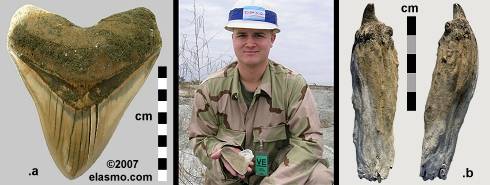
The New Jersey Paleontological Society, Tampa Bay Fossil Club (FL), National Aquarium (DC) and East Coast Fossil Club (NC) were joined by several non-club visitors on Sunday. Toward the end of fossil season, most expectations of finding a "bubba" meg tooth begin to wane. But for a few, that hope never quits. Dominic Sinibaldi (TBFC) hasn't been long back from deployment in the service to our country. From foreign locations last spring, he sent messages to save space for a fall collecting trip on his return. He finally got his Aurora trip today and was well rewarded. After receiving a few tips from Ron Edwards on how to find megs, he went out and did just that! Only a root ear was exposed on his massive 6-inch beauty (image A). Large shark teeth have seemed non-existent lately; apparently it takes the US Marines to root them out. Other interesting finds of the day included a generous-sized (hockey puck for you Yanks) chunk of fossil resin (Jeff Frey), Carcharodon carcharias lower (George Klein), large sperm whale tooth (Brett Cotton) and a very nice tuna jaw containing most of its teeth (Howie Cohn).

One group of special Saturday visitors was especially welcomed. Dr. Patricia Kelley of UNC-Wilmington brought her class of geology students to collect study specimens. Although the class was primarily focused on analyzing the available invertebrate fauna, the collections of whale, fish and shark fossils in some bags indicated a newly discovered interest in vertebrate fossils. A rare flat area of the mine worked quite well as a temporary classroom (below image).
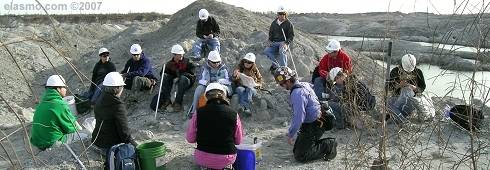
|
| November 25, 2007 |
|
Weekend 9 - Well, the weather wasn't nice
Pat Young reports: Winter has come to Aurora. Both days this weekend had frosty mornings, low 50's daytime temps and damp, cutting winds blowing across the Pamlico River. Although Saturday was sunny, Sunday skies stayed very dark all day, making for tough collecting. The small rain forecast for Sunday afternoon only touched on areas along the rivershore, leaving the mine pit untouched again. Groups visiting included American Fossil Federation (MD), Tidewater Gem and Mineral Club (VA), Black River Fossil Club (SC), Educators of Excellence (NC) and Hogtown Fossils (FL).
Megs both days were mostly laterals in the 2-1/2-inch class. Still, if it's your first ever, you have something to smile about. Wes Schaible joined the meg-owners family Saturday -- Congrats, Wes! Without rain, it's been hard to find untouched Yorktown soils, so those who moved around most did much better than those who picked a promising area to "work". Makos, tigers and sand shark teeth were all represented in most bags, although in smaller than hoped for quantities. Pungo area teeth had a decent showing but most people collected shells and molds from there. Beverly Horvath's oyster, Pycnodont (Gigantostrea) leeana (image), is striking example of the beauty of these Pungo offerings. The Carcharoides catticus specimen (image), is one of the more highly sought teeth in the mine and was found by Brady Hamilton; two small Carcharodon carcharias teeth were found by others.

Whale vertebrae are still being taken home by anyone who wants one. It's amazing that this late in the fossil season any are left. Teeth are much scarcer although Becky got a nice large one on Sunday; only the tip of her tooth was exposed. Quality bird fossils have been equally difficult to find this season but Russ Byer managed to find his fully exposed Razorbill auk ulna (Alca ausonia) (image) in very fine condition.
Although the new area of the mine is still mostly barren of vegetation, the older areas have begun to sprout. The plum tomato plant (Lycopersicon esculentum esculentum,image) probably took root as the result of someone's lunch leftovers. Found on the south side of a hill, it had suffered no frost damage and the fruits are destined for a Southern frying pan.
As a side note, a page has been added showing the horizons reflected in this year's "High wall".
|
| November 18, 2007 |
|
Weekend 8 - Well, the weather was nice
Pat Young reports: This weekend was a model for great fall fossil collecting weather. Although both mornings were frosty, the afternoons managed a pleasant 65 degrees. The 3/10ths of an inch of rain received on Thursday settled the dust and brightened the hills, but did little to expose fresh tailings. Clubs visiting Aurora on Saturday were Hampton (VA) City Schools Fossil Club and Tri-state Lapidary Club (SC); Sunday's groups were represented by Suanee Creek Fossil Club, Montgomery County Gem, Mineral and Lapidary Society (MD), Forsyth Gem and Mineral Club (NC) and Dry Dredgers (OH).
The question most heard was "what happened to the teeth"? Although cetacean bones, large pectens and other shells are still in abundance; bony fish and shark fossils are in short supply. Even the Pungo deposits are showing evidence of the severe drought that has hit NC this year. That said, the group atmosphere today was jolly.
Two inches is considered large for complete Yorktown teeth these days and Dusky (Carcharhinus obscurus) teeth have replaced Galeocerdo cuvier as the commonly exposed offering. Closer collecting techniques have resulted in some nice sand shark and Notorynchus teeth. More people are looking in the Pungo regions and this weekend several bramble shark teeth, one Carcharoides catticus (Becky Hyne) and a 7-inch sperm whale tooth (David Wright) were found in addition to the more commonly collected samples. One nearly two-inch shark vertebra was recovered by Frank Elder; his daughter Clara Jo got a slightly re-worked but complete 2-1/2" Carcharodon carcharias. Several people brought out fossils in matrix, including a small whale bulla and several vertebrae. George Oliver attempted recovery of what seemed an entire whale --he carried the skull on his back but enlisted the help of Reggie Titmus and Rich Johnson to carry the "other stuff".
In times like these, it's a pleasure to experience the friendliness and easy going nature of most fossil collectors. We've all see hard times before and know it will get better. One group that certainly deserves our appreciation are the teachers -- season after season they return to collect whatever they can to use for their classes. One never hears them complain and their buckets are always full to the brim.
|
| November 11, 2007 |
|
Weekend 7 - Carolina Geological Society
This weekend, PCS hosted the annual CGS field trip. Organized by Lauck Ward (VMNH) and Ralph Eshelman (formerly of Calvert MM & Smithsonian) with the help from PCS of Curtis Ormond, Sr. (Public Affairs), Tex Gilmore (Chief Geologist) & Jerry Waters (Mine Superintendent), 160 geologists had the opportunity to tour the facilities, board the dragline and collect the mine in multiple shifts. Visitors included several scientists who have a long history of Coastal Plain paleontological research as well as students and others who were new to the "Lee Creek" experience. The volunteer guides were supplemented with PCS employees such as Curtis Jr, Richard Peterson and Paul Pomeroy. Until a good rain, the tailings will be full of foot prints; it is unknown if this presence will have severely impacted the available fossils. The collecting area was expanded (north) to include a new hill which will be available to all through the end of the season. Few details of their finds are known, however two walrus tusks were recovered, one by a member on his first ever fossil collecting trip.
|
| November 4, 2007 |
|
Weekend 6 - Not enough rain
Pat Young reports: This weekend's fossil hopefuls consisted of the National Capitol Fossil Club (DC), Tarheel Gem and Mineral Club (NC), a group of teachers from the SE Coastal Ocean Sciences Educators of Excellence and several non-club affiliated visitors; many were new to the fossil collecting experience. The weather was typical for fall - cooler morning temps and warm, sunny afternoons. Saturday was very windy all day, keeping collectors close to the ground and Sunday morning sunshine revealed the first frost of the season. Although last weekend's heavy rains seem to have done little to enhance tooth collecting results, many buckets of fossil shells and whale bones, destined for school science programs, were taken.
Yorktown soils showed evidence of heavy traffic (large tiger shark teeth continue to be abundant), but most of the shark teeth were collected from the Pungo River Formation, with the largest 'megs' less than 3-inches. Diana Fattori reported her 2-1/2" one was the result of wearing a pink sweater she had borrowed; she also got a 1-3/4" black Hexanchus lower -- apparently, pink is the Italian good luck color. John Tunney and Ron Edwards got tiny ?meg teeth. Becky Hyne, BJ Blake, and Bonney Weathers each took home bramble shark teeth. Drew Miller & Nancy Brown showed Carcharodon carcharias and Notorynchus lower teeth, which had seemed moderately scarce, but were much more common this weekend. Other shark finds were the usual assortment of smaller teeth, vertebrae and cartilage.

Seal fossils have been more common this fall; this weekend Nando Musmarra got a 4-1/4 inch femur (image B) and John Timmerman a much smaller juvenile example. Other interesting finds include Squalodon teeth (1 molar and 2 premolars, missing most of their roots), partial turtle beak (Keith Robertson), complete lower marlin rostrum and several nice crocodilian teeth. Don Carr's (ref image A) complete cetacean periotic (inner ear) and posterior process was particularly noteworthy. The periotic directs sound into the bulla (outer ear). The posterior process is actually three bones lightly fused together which are attached to the periotic only slightly. The parts are rarely found articulated. The unusual V-shape of this specimen leads me to believe it is from a baleen whale.
One pleasure in visiting PCS is the varied wildlife one gets to see. The dragonflies are at their peak, the mosquitoes nearly so and the Tree swallows (Iridoprocne bicolor, ref. image) are taking full advantage. Hundreds of these small birds inhabit the highwall cliff and today were using the mine ramp for a resting place. It was easy to get within 4 feet of them before they took flight.
|
| October 27, 2007 |
|
Weekend 5 - Weekend cancelled -- Heavy rains
Pat Young reports: At 7:10am Saturday morning, PCS advised that the weekend's collecting would need to be cancelled for safety reasons; heavy rains not only affect the tailings, but the ramp and roads within the mine.
|
| October 21, 2007 |
|
Weekend 4 - We need rain
Pat Young reports: This week's (Saturday only) slots went to the North Carolina Fossil Club. Special visitors from the American Museum of Natural History, in Raleigh to set up a temporary dinosaur exhibit at the North Carolina Museum of Natural Sciences, accompanied them.
Although air temps were very pleasant, rains forecast for Aurora on Friday never happened. Dusty soil conditions made for tough collecting; those seeking a general collection of PCS fossils fared better than those wanting only large teeth. Quite a few of today's collectors were new to the Aurora experience and seemed happy to begin their collections with more prolific Pungo River offerings and invert material.

Cindy Muston and Bobby Tant showed the two largest Yorktown Carcharocles megalodons (3 & 2-1/2"); the top C. chubutensis (2-1/4") was found by Jerry Messick. Jennifer Hamby showed the only Carcharodon carcharias, a two inch upper missing most of its root. Broad-form Cosmopolitodus hastalis were reported only from areas showing little evidence of prior collecting. Knee-pad efforts produced some nice Notorynchus teeth (image right, 25 mm wide, Joanne Panek-Dubrock), one Hexanchus lower (in two parts, Joanne Panek-Dubrock), an Echinorhinus blakei (Joy Herrington) and many nice porpoise teeth; the latter included a lovely specimen by Ron Krantz (image center, 27mm high). Pathological teeth were shown by Joanne Panek-Dubrock, Keith Robertson and a split-tip Carcharhinus cf obscurus by Ron Krantz (image left, 22 mm high). BJ Blake gathered a partial whale skull with ear elements and Kevin Blanton two associated 4-1/4" teeth. Vertebrae and other cetacean bones, most destined for schools, are still filling buckets. The shortage of good fish fossils is likely to continue until some considerable rain falls (even Bonita noses are attracting attention this season).
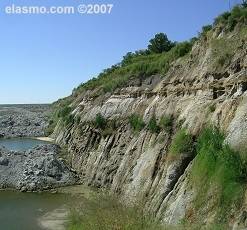 Even with dry conditions in NC, the mine highwall (image) is a vertical garden of lush foliage. Small underground streams continually flow, replenishing sandy vertical soils, and allowing for the growth of a variety of native grasses, water willow and false papyrus. The cliffs provide happy homes for flocks of insect hungry swallows while the ponds below offer abundant pristine breeding waters for many species of dragonflies.
Even with dry conditions in NC, the mine highwall (image) is a vertical garden of lush foliage. Small underground streams continually flow, replenishing sandy vertical soils, and allowing for the growth of a variety of native grasses, water willow and false papyrus. The cliffs provide happy homes for flocks of insect hungry swallows while the ponds below offer abundant pristine breeding waters for many species of dragonflies.
For many years John Everette has been an integral part of our Aurora experience. His ability to root out Yorktown treasures has surpassed most others. As Becky's sidekick (helper), he has kept the ball rolling on collecting days. On Wednesday, John had quadruple by-pass surgery. He's recovering well and will most likely slip out of the house at first opportunity to sneak back into the Aurora scene. We miss you and wish you well, John!!!
As a reminder, the South Carolina Fossil & Shell Fair is scheduled for October 27th (9am-3pm).
|
| October 16, 2007 |
|
Sea Monsters
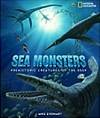 Tom Caggiano reviews: I was lucky enough to have the just released National Geographic film "Sea Monsters - A Prehistoric Adventure" playing at my local theatre. I shot over there and checked it out. The film is a quick 40 minutes and is viewed with a pair of special 3D glasses that you get when you buy your ticket. They were a nice quality plastic frame type unlike the cardboard type of years past. The film was shown early in the day, I guess to target young children more than an adult audience, however there were more adults present in the small audience. Tom Caggiano reviews: I was lucky enough to have the just released National Geographic film "Sea Monsters - A Prehistoric Adventure" playing at my local theatre. I shot over there and checked it out. The film is a quick 40 minutes and is viewed with a pair of special 3D glasses that you get when you buy your ticket. They were a nice quality plastic frame type unlike the cardboard type of years past. The film was shown early in the day, I guess to target young children more than an adult audience, however there were more adults present in the small audience.
The film covers the marine reptiles and other life of the Cretaceous Western Interior Sea that split North America in half during the Late Cretaceous. It highlights the life of a female Plesiosaur from birth till death. This time period and it fossils have been my main paleontological interest for over ten years and I have to tell you that I was really impressed by this film in many ways.
The most obvious special thing about the film was the 3D effects. I was astounded by the image quality and the true to life 3D view. The sea life was in your face, it really was great. The film was very well researched and was very accurate as far as what was said matching my existing knowledge. The content was presented so it could appeal to kids and adults. It uses short clips of fossils actually found in various localities around the world in order to illustrate how paleontologists put together knowledge gained from many different discoveries in order to piece together an accurate picture of life in the past. All of these clips were tied back in some way to the central figure female plesiosaur from Kansas.
The artist reconstructions and animation were just incredible and they truly brought these long gone creatures back to life. Small details added realism and we were able to see many interactions between these ancient creatures that the fossil record has shown us actually occurred. The film included the full cast of characters from the sea that once covered Kansas. I don't think anything was left out. Some species were never mentioned but they appeared in the background or quickly passing by our field of view. For me, it was great to see the fossils I've hunted for years and have held in my hands brought back to life in such an accurate way. I highly recommend this film for anyone interested in fossils and ancient life.
|
| October 13-14, 2007 |
|
Weekend 3 - Paleo-serendipity
Pat Young reports: Fall temperatures finally arrived at Aurora this weekend, making for a pleasant fossil grazing experience. Installed last week, the new ramp (thanks Curtis and Clyde) has a less steep incline and smoother walking path; a welcome addition, especially to those interested in gathering larger fossils. Saturday's group seemed more interested in whales (many bucket loads of vertebrae and other cetacean bones were recovered) while Sunday's crowd seemed primarily tooth hunters; the abundant Yorktown exposures kept both happy. Friends of the Museum invited special guests Matt Coon, Brian Martin and Mike Bartell (image), Marines from nearby Camp LeJeune , NC, to collect with us. Matt managed to fill his bucket with whale vertebrae and still give his buddies a lesson in bootcamp-training, fossil-style.

We've all heard the story of the 'big one' being found in the footprint of another, put this Saturday's fortuitous find is certainly one of the best. Departing the mine, Marco Gulotta's eye caught an object far down the side of the new ramp. Walking to the edge, he peered at it; the soft material gave way and he grabbed at the ground as he began to slide. Once stopped, he raised his hand to look at the object he'd clutched in the dirt -- a near-perfect 5-1/4" meg (img A)! Generally however, meg teeth were smaller and less abundant than the last two weekends.

Both upper and lower Notorynchus teeth are being seen more frequently; likely the result of closer looking after the season's initial rush. Don's Carr's upper cowshark tooth, measuring 1 inch in height, (img E) was determined by the majority present to most probably be Hexanchus due to it's large size. Carcharodon carcharias teeth were collected by Gary Grimsley and Gregg Walden (2-inch) and Teresa Hardin (1-1/4"). Howie Cohn (LA2, img C) and Joel Hardin found Isurus retroflexus teeth in Pungo sediments. Pathological teeth, always fun finds, were shown off by Shannon Roberts (?G. cuvier, img F) and Ted Kordela (lamnid, img D). One Parotodus benedini was found this weekend, measuring 2-1/4 inches, and Becky got a tiny posterior Bramble shark tooth. Broad-form Cosmopolitodus hastalis, Galeocerdo cuvier and Hemipristis are still very plentiful; smaller shark teeth less so.

Seal fossils continue to be found regularly; John Herrick and Keith Robertson got 2-inch canine teeth, Bill Heim a beautiful molar (img B) and Rita McDaniel a jawbone with molar attached; one other seal mandible was seen (missing teeth). Keith also got a seal metacarpal and phalange and Matt Coon a nice carpal bone. Other marine mammal fossils included a pilot whale tooth (Steve Young), a Squalodon molar in limestone matrix and a few small whale teeth. Lack of weathering has caused smaller fish fossils to be scarce this season but Ed Ternosky managed to get the season's first black drum (Pogonias cromis) lower pharyngeal toothplate. George Powell and Sandy Shelton collected the first Psammechinus philanthropus urchins of the season.
Although the immense size of the current collecting area is handling the fall collectors well, we look forward to a heavy rain soon.
|
| October 6-7, 2007 |
|
Weekend 2 - Beat by the heat
Pat Young reports: Extremely dense fog, high humidity and temperatures in the upper 80's plagued PCS fossil collectors Saturday and Sunday. Saturday's group experienced a half hour of rain in the morning, but the cooling it provided was brief. Both days' groups consisted of Friends of the Museum members. The largest Carcharocles megalodon shown was Gregg Walden's 6-inch UA1 (missing a root lobe); others included: Tom Caggiano (3-½" Pungo lateral & 3-1/4" Yorktown lower), Becky Hyne (4-1/2, 3-1/4 (image - center) & 5-incher in three pieces), Allen Lightfoot (3"), Talban Kantala (3" and two smaller ones), Fred Mazza (2-¾") and Gina Moore & Tom Newquist each picked up shiny black laterals (2-1/4" and 2-1/2"). Ernie Wooten got a chubutensis in Pungo matrix; many smaller Carcharocles were seen.
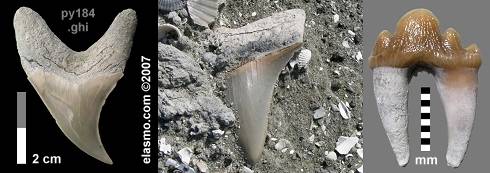
Parotodus benedini collectors had a great weekend. Becky and Bill Leonard got 2-inchers, Fred Plumb a very nice 1-1/4 inch tooth (image left) and Brian Hempy two more (2" lateral & 1-1/2" posterior, found about three feet apart). Carcharodon carcharias was represented by David Zuckerman's 1-1/4" and 1-inch teeth found on Sunday. Ron Edwards reported the only Hexanchus lower. Broad-form Cosmopolitodus hastalis are still plentiful but Fred Plumb's 3-1/4" tooth was spectacular. Galeocerdo cuvier teeth are extremely abundant but smaller teeth of all species seem to be in short supply.
Other interesting finds of the weekend included: seal molars (Fred Plumb, George Oliver & David Griffith - image right), Squalodon molar (Stan Griggs), whale periotic (earbone) with attached posterior process (Ron Edwards), seal claw cores (Ron Edwards and Pat Young), ray scutes (Keith Robertson's was heart-shaped), partial wahoo dentary with six teeth (Ernie Wooten) and another crocodile vertebra (Matt Wojtka, Roxada Story got one last weekend).
The Aurora area is still waiting for heavy rain; when it comes, this mine tract should produce the best fossils we've seen in years.
|
| September 29-30, 2007 |
|
Weekend 1 - What's with those smiling faces?
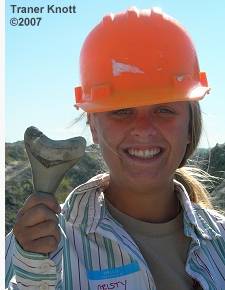 Pat Young reports: The much anticipated PCS fall collecting weekend began with the best of everything -- bright sunshine, temps in the low 70's, light breezes throughout the day and old friends excitedly re-connecting (news of fresh tailings heightened the enthusiasm of all); Curtis Ormond paid a brief visit to wish us luck. This weekend's group consisted of Friends of the Museum members and Festival volunteers.
Pat Young reports: The much anticipated PCS fall collecting weekend began with the best of everything -- bright sunshine, temps in the low 70's, light breezes throughout the day and old friends excitedly re-connecting (news of fresh tailings heightened the enthusiasm of all); Curtis Ormond paid a brief visit to wish us luck. This weekend's group consisted of Friends of the Museum members and Festival volunteers.
It certainly would be easier to write a report of what wasn't found on this weekend trip -- nearly every highly esteemed fossil was represented in the two days and the smiles on the faces of the participants were as generous as the bounty they hauled away.
The "Megalodon yell" was heard from all parts of the mine with the largest a Yorktown Carcharocles megalodon found by Tom Savisky. Although missing a portion of the root, it still measured a whopping 5-1/4 inches! Sandy Shelton (Fig B) and first-time collector Cristy Barrett (guess which image) got their first ever megs; Sandy's was 4-1/2" and Cristy's 4". Cristy reported that after finding her meg and finding no one nearby to report it to, she didn't know what to do with it! After carefully wrapping it, she waited until Candace assured her it was hers to keep.
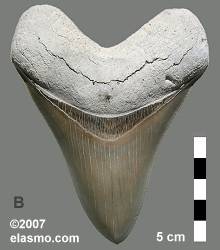 Large megs were also seen in the new pickings of Eric Sadorf & Bill Killen (4-1/2"), Paul Murdoch (3-3/4"), Mel Gulotta (3-1/2") and Jeff Sparks (3"). Anne Lineberry got her tooth the lazy way --she stumbled across a nice 3-1/4" meg that had been recently raked out and overlooked by an unobservant hunter. Heather Greer's 3-3/4" posterior inspired much discussion on the potential size of it's previous owner. So many smaller megs and chubbies were found it was impossible to document them all. The larger megs came mostly from the more weathered tailings to the right of the ramp.
Large megs were also seen in the new pickings of Eric Sadorf & Bill Killen (4-1/2"), Paul Murdoch (3-3/4"), Mel Gulotta (3-1/2") and Jeff Sparks (3"). Anne Lineberry got her tooth the lazy way --she stumbled across a nice 3-1/4" meg that had been recently raked out and overlooked by an unobservant hunter. Heather Greer's 3-3/4" posterior inspired much discussion on the potential size of it's previous owner. So many smaller megs and chubbies were found it was impossible to document them all. The larger megs came mostly from the more weathered tailings to the right of the ramp.
Those not finding megs still came away with at least one great item for their collections. Many beautiful specimens of the broad-form Cosmopolitodus hastalis were found, but Dave Grabda's 3-inch beauty (Fig. F) was second to none. Several narrow-form C. hastalis in the 2-1/2 inch size range were seen. Becky Hyne showed off a nice upper anterior tooth of Isurus retroflexus inspiring collectors to reexamine their own days' take, but no others were seen. At least seven Carcharodon carcharias were found, all in very good condition. Other outstanding shark finds of the weekend included John Adams' two bramble teeth, Kyle Grimsley's Hexanchus lower and Richard Aultman's large Parotodus benedeni.
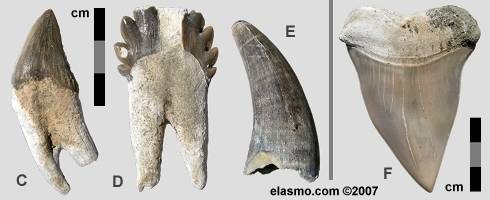
Marine mammal fossils seemed more abundant in the fresher left side and were equally impressive. George Powell managed to pick up a seal molar just inside the mine; several seal canines and one partial seal jaw with a molar were also found. Eric Fritz, John Timmerman (2-1/4", Fig. C), Judy King and John Kekak showed off Squalodon teeth but I heard of others. BJ Blake got a nearly perfect small whale bulla. Two fossil curiosities showed that are likely to talked about for a while. The Pungo sediments yielded for Lee Cone what appeared to be some sort of ancient cetacean tooth (Fig. D) not normally seen here. Mel Gulotta's large Yorktown whale tooth (at 6-inches, it was nearly flat and hook-shaped, but too encrusted to image) was also not familiar to any of us. Rather than rely on parking lot conjecture, both will follow up on identification and provide an update. Other finds include tuna and barracuda jaws with teeth and at least seven nice crocodile teeth, including a two-incher by Andy Albright (Fig. E).
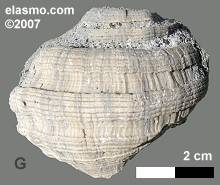 In 1987, the Smithsonian Department of Paleobiology published a paper by Druid Wilson (in Geology and Paleontology of the Lee Creek Mine, North Carolina, II) introducing a new subgenus of Ecphora from the lower Pungo River Formation named Stenomphalus. Shortly thereafter, these shells seemed to disappear and none were noted until this past summer when they began to show up occasionally in newly processed 'reject'. This weekend several of these interesting shells were found in the lower Pungo tailings of the mine (generally called 'pit-car' tailings). The imaged specimen (Fig. F) was found by Joy Herrington.
In 1987, the Smithsonian Department of Paleobiology published a paper by Druid Wilson (in Geology and Paleontology of the Lee Creek Mine, North Carolina, II) introducing a new subgenus of Ecphora from the lower Pungo River Formation named Stenomphalus. Shortly thereafter, these shells seemed to disappear and none were noted until this past summer when they began to show up occasionally in newly processed 'reject'. This weekend several of these interesting shells were found in the lower Pungo tailings of the mine (generally called 'pit-car' tailings). The imaged specimen (Fig. F) was found by Joy Herrington.
I think it fair to say this was one of the best fossil weekends we have ever experienced. The larger area and abundant well-weathered soils should provide generously for a while to come --even if the rains by-pass Aurora for a bit longer.
|
| September 24, 2007 |
|
On your mark, Get set
Pat Young reports: While setting boundary stakes on Saturday, I got a decent overview of the fall collecting area. The new ramp is approximately 1/2 mile north (toward the Pamlico River) of the ramp that was used for spring season. The current collecting area extends toward the right from the new ramp to last season's ramp and over halfway the length of the mine. Reclamation continues in the right rear of the pit and those areas are strictly off limits. The mud flows are fluid and unstable and prone to move very rapidly. Due to the constantly advancing movements, no stakes were set in those areas but fossil collectors are required stay at least 300 feet from any spoils.
Temperatures in Aurora are still consistently near 90 degrees with extremely high humidity. It can easily take 1-1/2 hours to walk from the far side of the mine back to the exit ramp. Given the huge collecting area, early season collectors should bring extra water; it's not unreasonable to expect to drink 1 quart per hour. Salty and sweet munchies and loose clothing will make the heat easier to deal with.
The new ramp is steeper than we've been accustomed to, composed mostly of sand and will require some extra effort to exit the mine. Due to the rapid progression of the mining efforts, the collecting area near the ramp is still fairly fresh, but the hills are steep and will wash well now that the dry season is over. The older areas toward the south should be at their prime now. We expect to have a great collecting season!
|
| August 22, 2007 |
|
Season Confirmed
Received confirmation from Curtis yesterday that if the hurricane season permits, a fall collecting season will begin on September 29th; a new ramp is under construction to access the new tailings. (The draglines are currently at a position equal to the upper end of the lake of the aerial image.)
As usual, previous safety rules will apply: hard hats, steel-toed footwear, long pants & shirts (with sleeves), etc and a photo-ID will be required to get a visitors' pass. Please meet in the PCS contractors' parking lot (usual place) across from the Main Gate by 7am.
|
| August 12, 2007 |
|
Fall 2007 Season
Although there has been no official approval of a fall season, plans are proceeding in that direction; Curtis Ormond will be accepting e-mail requests between Aug 15th and 31st (only). As usual, Friends of the Museum will be allocated the first five or six slots.
Reclamation efforts have continued over the summer and most tailings collected last spring are no longer available. The area anticipated to be opened to fall collectors includes extensive (although only partially weathered) Yorktown sediments.
|
| June 21, 2007 |
|
Aerial Images
 In my youth (early 20s), I could instinctively meander the streets and alleys of Fez without problem; but there are areas (Long Island & NE New Jersey) that totally challenge my geo-space positioning. The Lee Creek mine has been another example of me being geo-positionally challenged. I hope the newly added "aerial page" will help others to better understand where they find (found) themselves (click image). In my youth (early 20s), I could instinctively meander the streets and alleys of Fez without problem; but there are areas (Long Island & NE New Jersey) that totally challenge my geo-space positioning. The Lee Creek mine has been another example of me being geo-positionally challenged. I hope the newly added "aerial page" will help others to better understand where they find (found) themselves (click image).
|
| June 6, 2007 |
|
Castle Hayne Fauna Page
The last five-years at elasmo.com have been preoccupied with slideshows and the Lee Creek teleost page. Last October, Richard Chandler and I decided that adding the Castle Hayne Formation's fauna would be a worthy project. It took us six-months to work our way through the stratigraphy and fauna, but we feel you will be pleased with the results. For many of us from the north, a Castle Hayne visit usually accompanied our seasonal trips to Lee Creek. For those not familiar with this Eocene fauna, you might better understand our motivation: Castle Hayne Fm, — Middle Eocene Sharks & Rays of North Carolina.
Enjoy the summer and one last "Thank You" to PCS & Curtis Ormond for the Spring 2007 collecting season and Pat Young for sharing it with us.
|
|
|